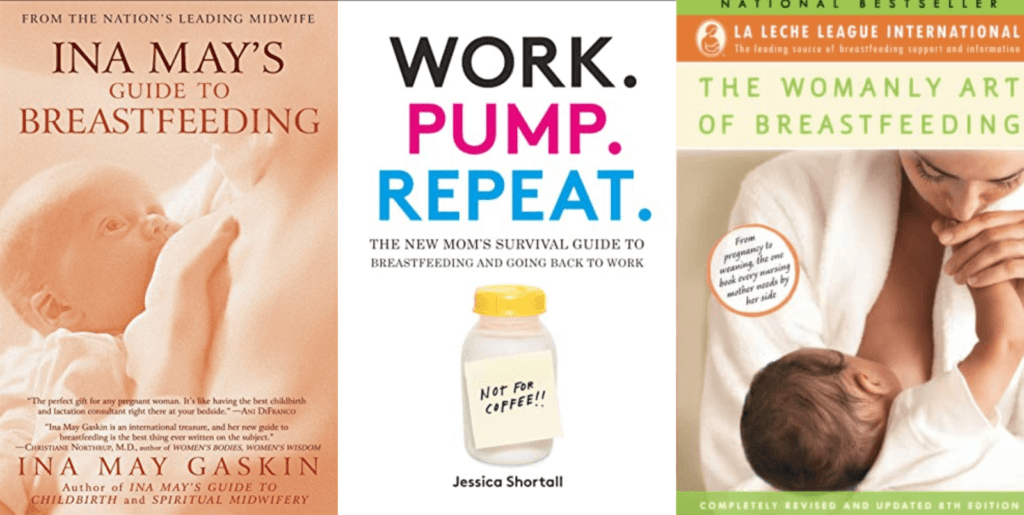This post contains 10 tips for successful breastfeeding to make nursing your baby easier.
Disclosure: Some of the links below are affiliate links. This means that, at zero cost to you, I will earn an affiliate commission if you click through the link and finalize a purchase.
How Breastfeeding Works
Breastfeeding is a natural way for mothers to provide nourishment and immunological protection to their infants.
The milk production process starts during pregnancy with hormones preparing the breast tissue to produce milk.
After delivery, the baby suckles at the breast, stimulating sensory receptors that trigger the release of the hormone prolactin from the pituitary gland.
Prolactin stimulates the alveoli in the breast to produce milk. (source)
As the baby continues to suckle, more milk is produced, and the milk is released through small ducts that lead to the nipple.
This release is triggered by the hormone oxytocin, which causes the smooth muscle cells around the alveoli to contract and push the milk out.
Breast milk is unique to each mother and changes in composition depending on the baby’s needs. (source)
It contains a combination of proteins, fats, carbohydrates, vitamins, minerals, and immune-boosting factors that help the baby grow and develop.
It is essential to establish a correct latch and feeding position to prevent discomfort or issues like engorgement, plugged ducts, or mastitis.
Breastfeeding can be challenging at first, but with support and practice, most mothers can successfully breastfeed their babies and enjoy the many health benefits associated with it.
Related: Top 8 Breast Pumping Tips For New Moms
Benefits of Breastfeeding for Baby’s Health
Breastfeeding has numerous health benefits for babies, some of which include:
1. Nutritional Benefits: Breast milk is the perfect food for babies as it contains all the necessary nutrients, vitamins, and minerals required for healthy growth and development. (source)
2. Immune System Support: Breast milk contains antibodies that help to protect babies against infections, illnesses, and diseases. It also helps to strengthen their immune system, reducing their risk of allergies and chronic conditions. (source)
3. Brain Development: Breast milk contains essential fatty acids such as DHA and AA that are crucial for brain development. Studies have shown that breastfed babies have higher IQ levels and better cognitive development. (source)
4. Digestive Health: Breast milk is easily digestible and gentle on a baby’s digestive system. It can help to reduce the likelihood of constipation, diarrhea, and other gastrointestinal problems. (source)
5. Reduced Risk of SIDS: Breastfeeding has been shown to significantly reduce the risk of sudden infant death syndrome (SIDS). (source)
6. Lowered Risk of Chronic Diseases: Breastfed babies have a lower risk of developing chronic conditions such as obesity, diabetes, heart disease, and cancer later in life. (source)
Related: Best 70 Pregnancy Hacks (+Products Recommendation)
Different Positions for Breastfeeding
There are various positions for breastfeeding that can be comfortable for both you and your baby.
Here are some of the most common ones:
1. Cradle hold: This is a classic position where you hold your baby across your lap with their head resting in the crook of your arm on the same side as the breast you will be nursing from.
2. Cross-cradle hold: Similar to the cradle hold, but your opposite arm supports your baby’s head and neck instead of the same arm as the nursing breast.
3. Football hold: In this position, the baby lies at your side with their feet towards your back and their head at the level of your breast. You can support your baby’s neck and shoulders with one hand while they latch on.
4. Side-lying position: This position can be great for nursing while lying down. You and your baby lie on your sides facing each other with your baby’s head at the level of your breast.
5. Laid-back position: Also known as biological nurturing, you recline with your baby on top of you, allowing them to find their own way to your breast.
It’s important to find the position that works best for you and your baby and that feels comfortable and supportive.
Related: Best 7 Pregnancy Self Care Products
Common Breastfeeding Challenges
Here are some common breastfeeding challenges that new mothers may face:
1. Painful nipples: This is one of the most common breastfeeding challenges. Newborns may have trouble latching properly, which can lead to painful nipples.
2. Low milk supply: Some mothers experience a low milk supply, which can make breastfeeding difficult.
3. Engorged breasts: Breasts can become swollen and painful when they are full of milk. This can make it hard for babies to latch onto the nipple.
4. Blocked milk ducts: Sometimes milk can become trapped in the milk ducts leading to a blocked milk duct. This can cause discomfort and pain.
5. Breastfeeding in public: Some mothers may feel uncomfortable breastfeeding their baby in public.
6. Breastfeeding in irregular positions: Breastfeeding in awkward or uncomfortable positions can lead to back pain.
These challenges can be overcome with the help of your healthcare provider, lactation consultant, and support from family and friends.
Related: Top 12 Tips On How To Deal With Morning Sickness At Work
10 Tips For Successful Breastfeeding
#1. Educate Yourself About Breastfeeding
1. Attend a breastfeeding class: Many hospitals, clinics and community centers offer classes for new parents to learn about breastfeeding.
These classes are led by lactation consultants or experienced nurses who can teach you the basics of breastfeeding, how to position your baby, how to latch properly, and how to troubleshoot common breastfeeding challenges.
2. Read books: There are many great books available on breastfeeding that can help you prepare for your new role as a breastfeeding mother.
Related: Best 10 Breastfeeding Books
3. Join a breastfeeding support group: Find a local breastfeeding support group where you can connect with other breastfeeding mothers.
You can ask questions, share your experiences, and get support and encouragement from other moms who are going through the same journey as you.
4. Talk to a lactation consultant: Lactation consultants are experts in breastfeeding who can provide personalized guidance and support.
They can help you overcome any challenges you may face, such as low milk supply, nipple pain, or difficulties with latching.
#2. Stock Up On Breastfeeding Essentials
When it comes to breastfeeding, there are some essential items that can make the experience more comfortable and successful.
Here are some breastfeeding essentials:
1. Nursing bras: These bras are designed with special flaps or openings for easy access to the breasts and provide support while nursing.
2. Breast pads: These absorbent pads help prevent leakage and keep your clothes dry.
3. Nipple cream: This is helpful in soothing sore nipples and promoting healing.
4. Breast pump: This can be useful for maintaining milk supply, relieving engorgement, and allowing others to feed the baby.
5. Nursing pillow: A specially designed pillow can provide comfort and support for both you and your baby during nursing sessions.
6. Nursing cover: This can provide privacy and help you feel more comfortable nursing in public.
Related: Breastfeeding Resources (Information, Apps, Books, Podcasts)
#3. Find A Breastfeeding Support System
Finding a breastfeeding support system can be very beneficial for new moms who are just starting out.
Here are some tips on how to find one:
1. Reach out to your healthcare provider: Your doctor or midwife can connect you with resources such as lactation consultants, local breastfeeding support groups or other professionals who can offer you support.
2. Join local mom groups: There may be local mom groups in your community that focus on breastfeeding, infant care, and parenting support.
You can join these groups to meet other moms who have been through the same experience and can offer you advice and support.
3. Attend a breastfeeding class: Many hospitals and birth centers offer classes for new moms interested in breastfeeding.
By attending these classes, you can learn more about the benefits of breastfeeding and find support from other new moms.
4. Use online resources: There are many online resources for breastfeeding support, such as La Leche League International.
These resources provide helpful information on breastfeeding, common breastfeeding issues and connect you with others who have been through similar experiences.
- La Leche League – Inducing Lactation & Relactation
- La Leche League – Tandem Nursing (Tandem nursing is defined as a “common term for breastfeeding siblings concurrently”)
- La Leche League – Special Needs Breastfeeding Support
Remember that finding a breastfeeding support system takes time and effort, but it’s worth it.
With the right support system in place, you can successfully breastfeed your baby and feel more confident throughout your breastfeeding journey.
#4. Practice Latching Techniques
Latching breastfeeding is the process where a baby attaches to their mother’s breast to feed.
A good latch involves the baby taking a big mouthful of the breast, with their lips flanged out and forming a tight seal around the nipple and areola.
This creates a vacuum that enables the baby to suckle effectively and comfortably, while also stimulating the breast to produce more milk.
A good latch can help prevent sore nipples, improve milk flow, and ensure that the baby gets enough milk to grow and develop properly.
Here are some common latching techniques that can help:
1. C-hold: Position your hand in a “C” shape and place it behind your baby’s head, using your fingers to support the neck.
2. Football hold: Sit in a chair and position your baby under your arm like a football, with their legs and feet tucked under your arm.
3. Cross-cradle hold: Place your baby’s head in the crook of your elbow and support their neck with your hand. Use your other hand to guide your breast towards your baby’s mouth.
4. Side-lying position: Lie on your side with your baby facing you. Align your baby’s mouth with your nipple, and use your hand to support their head and neck.
Remember, there is no one “right” way to latch your baby.
It may take some trial and error to find the position that works best for both you and your baby.
The key is to stay relaxed and patient, and seek help from a lactation consultant or other breastfeeding support if needed.
Related: Minimalist Hospital Bag Checklist (+Hospital Bag Checklist PDF)
#5. Figure out Timing And Frequency of Feedings
Breastfeeding babies should be fed on demand, which means whenever they show signs of hunger such as sucking on their fists or crying.
Newborns will often want to nurse every 2-4 hours, but some may cluster feed and eat more frequently for a period of time. (source)
As babies grow, they may become more efficient feeders and go longer stretches between feedings.
It is important to offer the breast frequently, especially in the first few weeks, to establish milk supply and ensure that the baby is getting enough nutrients.
Overall, it is recommended that breastfeeding babies are fed at least 8-12 times within a 24-hour period. (source)
For babies older than 6 months old, continue to breastfeed whenever you notice signs of hunger.
It is important to note that every baby is different, and some may require more or less frequent feedings.
If you have concerns about your baby’s feeding schedule or weight gain, it is always best to consult with a healthcare professional.
Related: How To Combine Breastfeeding And Pumping?
#6. Address Common Breastfeeding Issues
Engorgement
Engorgement commonly happens to breastfeeding mothers when the breasts become too full and uncomfortable. (source)
Here are some ways to relieve engorgement:
1. Nurse frequently: Frequent nursing is the most effective way to reduce engorgement. Offer your baby both breasts during each feeding.
2. Hand express milk: You can use your hand or manual breast pump to express milk before and after feeding.
3. Hot and Cold compresses: Applying warm compresses or taking a warm shower can help stimulate milk flow and reduce breast pain. While applying a cold compress or ice pack to the breasts can reduce swelling and relieve discomfort.
Use warm compresses for 10 minutes before nursing and cold packs for 10 to 15 minutes after nursing. (source)
4. Massage the breast: Gently massaging the breast, starting from the outside and moving towards the nipple can help reduce engorgement.
5. Wear a supportive bra: Wearing a comfortable and supportive bra can help relieve breast pain and provide gentle pressure to reduce swelling.
In severe cases of engorgement, it’s important to seek medical advice from your doctor or lactation consultant.
Sore Nipples
Sore nipples can be a common problem for nursing mothers, especially in the first few weeks after giving birth.
Here are a few ways to help relieve sore nipples:
1. Adjust your position while breastfeeding: Try different nursing positions to find the one that works best for you and your baby. Make sure your baby is latching on properly and not just sucking on the nipple.
2. Apply warm compresses: Apply a warm, moist compress to your nipples before breastfeeding to help soothe soreness.
3. Air out your nipples: After nursing, expose your nipples to air for a few minutes to help dry and heal them.
4. Use nipple creams or ointments: Use a lanolin-based cream or nipple ointment to help soothe sore nipples. Apply it after each feeding.
5. Avoid using soap on your nipples: Soap can dry out your skin and make your nipples more sensitive. Instead, rinse your nipples with water and pat dry.
If your nipples are severely sore or cracked, please consult with a healthcare provider.
Clogged Milk Ducts
Clogged milk ducts feels like a tender, sore lump or knot in the breast. This results in a decrease in milk flow or complete blockage of milk flow in some cases.
It is a common breastfeeding problem that can occur due to factors such as inadequate breastfeeding, poor latching, skipped feedings, or wearing tight bras.
If left untreated, it can lead to mastitis, a breast infection.
Engorgement vs clogged duct
When a duct is blocked, discomfort and swelling are confined to a small lump on the breast, whereas engorgement usually impacts a wider area.
There are several ways to clear clogged milk ducts, including:
1. Massage the affected area: Use gentle massage and pressure to encourage the milk to flow and to help clear the blockage.
2. Apply heat: Place a warm compress on the affected area to promote blood flow and encourage milk flow.
3. Pump or nurse frequently: Frequent nursing or pumping can help to keep milk flowing and prevent blockages from occurring in the first place.
4. Change nursing positions: Experiment with different nursing positions to ensure that milk is being fully drained from all areas of the breast.
5. Take pain relief medication: Over-the-counter pain relief medication, such as ibuprofen, can help to reduce pain and inflammation caused by blocked milk ducts. (source)
6. Consult a lactation consultant: If you are experiencing persistent or severe blocked milk ducts, it may be helpful to consult with a lactation consultant for personalized advice and guidance.
Mastitis
Mastitis is a painful inflammation of the breast tissue that is usually caused by a bacterial infection.
Here are some steps you can take to treat mastitis:
1. Warm compress: Applying warm compresses to the affected area can help reduce inflammation and pain. You can use a warm wet towel or a heating pad for this.
2. Massage: Massaging the breast gently while breastfeeding or pumping can help move milk out of the breast and relieve inflammation.
3. Antibiotics: If the mastitis is caused by a bacterial infection, antibiotics may be necessary. Speak to your healthcare provider to determine the appropriate antibiotic therapy. (source)
4. Pain relief: Taking over-the-counter pain medications such as ibuprofen or acetaminophen can help relieve pain and reduce inflammation. (source)
5. Continuous breastfeeding or expressing milk: Continuing to breastfeed or pump regularly can help to relieve the pressure of the built-up milk, and helps prevent further clogging of the ducts.
6. Proper drainage: Ensure that proper milk drainage occurs during feedings to help avoid further clogging or engorgement. If symptoms persist or worsen, it is important to consult with a healthcare provider.
Related: Best 10 Postpartum Books
#7. Increase Your Milk Supply
There are several ways to help increase milk supply:
1. Nurse frequently: Breastfeeding often and on demand can help stimulate milk production.
2. Pump after nursing: Using a breast pump to remove any remaining milk after nursing can also help stimulate milk production.
3. Stay hydrated: Drinking plenty of water can help maintain milk supply. The general guideline is to drink about 16 cups (128 ounces) of water per day, but some may need more depending on their individual needs and activity level. (source)
4. Eat a healthy diet: Eating a well-balanced diet that includes protein, healthy fats, and complex carbohydrates can help support breastfeeding.
5. Rest and relax: Getting enough sleep and reducing stress levels can help support milk production.
6. Consider herbal supplements: Some lactation consultants recommend certain herbs, like fenugreek or blessed thistle, to help increase milk supply. However, it’s important to talk with a healthcare provider before taking any herbal supplements.
If you’re still struggling with low milk supply despite these measures, it’s important to seek advice from a lactation consultant or healthcare provider.
#8. Safely and Discreet Breastfeeding In Public
Breastfeeding is a natural and necessary process for women who have infants. It is important to feel comfortable breastfeeding in public, but it can also attract unwanted attention.
Here are some tips for discreet breastfeeding in public:
1. Wear nursing-friendly clothing: Clothing that allows ease of access to the breast while maintaining coverage is essential. Clothing with buttons, zips, or snaps can help you nurse discreetly.
2. Use a nursing cover: A nursing cover can help you create privacy and avoid any unwanted attention while feeding your baby in public.
There are a variety of nursing covers available in the market, from lightweight muslin blankets to full-coverage apron-style covers.
3. Practice at home: Practicing at home can help you master the art of discreet breastfeeding before you head out.
Experiment with different positions and techniques to find the one that works best for you and your baby.
4. Choose the right spot: Look for a quiet and comfortable spot to feed your baby. Avoid crowded spaces or areas with too much noise and activity.
5. Surround yourself with supportive people: Being surrounded by supportive friends and family members can make a huge difference.
It can help you feel more comfortable and confident while breastfeeding and can also help you deal with any unwanted attention from strangers.
Related: Best 10 Newborn Care Books
#9. Plan For Your Return To Work While Breastfeeding
Returning to work while breastfeeding can be challenging, but with some planning and preparation, it is very doable.
1. Plan ahead: Before returning to work, create a plan for pumping and storing breast milk. Talk to your employer about options for pumping breaks and where you can store your milk during the workday.
2. Invest in a good breast pump: A good breast pump is crucial for successful breastfeeding while working. Look for a double electric pump which is efficient and can save time.
3. Build up a supply: Start building up a stash of pumped milk several weeks before returning to work, so you have an extra supply available when needed.
4. Practice pumping before returning to work: Practice pumping at home so you can become familiar with how your pump works, and get comfortable with the sensation.
5. Stick to a pumping schedule: To ensure a steady flow of milk, try to establish a consistent pumping schedule. Aim to pump every 3-4 hours during the workday.
6. Use a hands-free pump: A hands-free pump allows you to multitask while pumping, making it easier to work while pumping.
Remember that it takes time to adjust to a new routine with pumping and returning to work. Be patient and kind to yourself throughout the transition.
#10. Take Care Of Yourself While Breastfeeding
Breastfeeding is a special time for you and your baby, and it’s essential to take care of yourself during this period.
Here are some tips to help you maintain your health and wellbeing while breastfeeding:
1. Get enough rest: Getting enough rest is essential when you are breastfeeding. Try to nap when your baby is sleeping and go to bed early to ensure you get enough sleep.
2. Take care of your breasts: Breastfeeding can be tough on your breasts, so take care of them by using nursing pads, wearing a supportive bra, and using nipple cream if needed.
3. Exercise regularly: Exercise can help boost your energy levels and improve your mood. Make sure to get regular exercise, but avoid activities that could lead to injury.
4. Reduce stress: Stress can interfere with your milk production, so try to reduce stress levels by practicing relaxation techniques like meditation or yoga.
Remember, taking care of yourself is just as important as taking care of your baby.
Related: Minimalist Baby Essentials
Conclusion
Breastfeeding is a natural way to provide nourishment and immune protection for babies.
It can also be an incredibly bonding experience for both the mother and baby.
If you have any questions or concerns about breastfeeding, speak with a lactation consultant or your healthcare provider.
They can provide guidance and support, as well as resources to help you succeed in your breastfeeding journey.
It’s important to note that breastfeeding may not be possible or comfortable for all mothers and that’s okay.
Fed is best, so whatever feeding method works best for you and your baby is the right choice.




